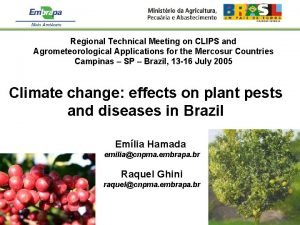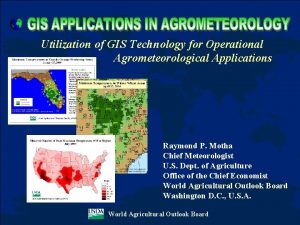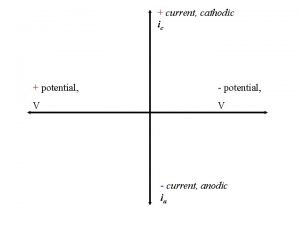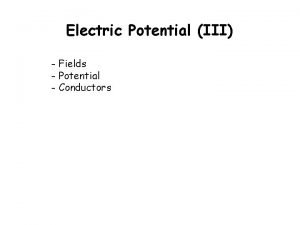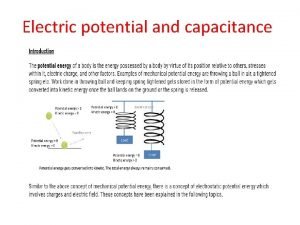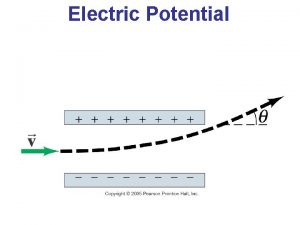REVIEW OF CURRENT AGROMETEOROLOGICAL APPLICATIONS AND FUTURE POTENTIAL















- Slides: 15

REVIEW OF CURRENT AGROMETEOROLOGICAL APPLICATIONS AND FUTURE POTENTIAL IN URUGUAY (MSc) Mario Bidegain Dirección Nacional de Meteorología Uruguay Regional Technical Meeting on CLIPS and Agrometeorological Applications for the Mercosur Countries 13 - 16 July 2005, Campinas – Sao Paulo - BRAZIL

Country background • Uruguay is located in the south-eastern part of South America, located between 30° to 35° South and 53° to 58° West. • It is bordered on the west by Argentina, on the north and north-east by Brazil, on the south by the Río de la Plata, and on the east by the Atlantic Ocean, covering 176, 000 km 2. • Montevideo, the capital city, and most of Uruguay’s population are located on the coast of the Río de la Plata.

Topography • The country consists mostly (75%) of gently rolling plateau, interrupted at two points by low hilly ridges (maximum heigth 500 mts). The remainder of the country is fertile coastal lowlands, including a narrow coastal plain and the somewhat broader littorals of the Río de la Plata and Río Uruguay.

Cultures and productions http: //www. mgap. gub. uy/Diea/Anuario 2004/indice_mapas. htm Red: agriculture (maize, soybean, wheat and barley) Green: grassland meat production Grey: Dairy production Purple: Fruits and vegetables Blue: Rice Yellow: Citrics Brown: Forest

National meteorological network

Agrometeorological products produced by D. N. M. (Dirección Nacional de Meteorología) (http: //www. meteorologia. com. uy) • Daily rainfall bulletin (web page) • Decade, monthly and annual climate statistics. • Climate maps (rainfall, mean and extreme temperatures, rainfall days, anomalies, etc. ) (web page) • Users tailored reports • Water balance and soil moisture monitoring. • Diagnosis of climate anomalies • Forecasting of seasonal climate (web page) • Routinely weather forecasting (web page)

Agrometeorological products produced by I. N. I. A. (National Institute for Agriculture Research) http: //www. inia. org. uy/disciplinas/agroclima/index. html • Climate monthly maps of accumulated rainfall, and anomalies. (web page) • Water balance and soil moisture monitoring. (web page) • NDVI monthly vegetation monitoring (web page)

Regional and National research related to agrometeorology 1. Projects funded by the Inter-American Institute for Global Change (IAI) 2. ISP II 1997 – 2000 3. 4. Climate Variability and Agriculture in Argentina and Uruguay: Assessment of ENSO Effects and Perspectives for the use of Climate Forecast. Countries: Argentina – Uruguay – USA 5. CRN 2000 -2005 6. Development of a Collaborative Research Network for the Study of Regional Climate Variability, Changes and Prediction in the MERCOSUR Area. Countries: Argentina – Brazil - Paraguay - Uruguay – USA 7. 8. 9. SAAC: An International Consortium for the Study of Global and Climate Changes in the western south Atlantic. Countries: Argentina – Brazil - Uruguay – USA 10. Project funded by INIA (Uruguayan Government and Private Sector) 11. FPTA 2000 -2002 12. Applications of Climate Forecast in the agricultural Sector 13. 3. Project funded by MVOTMA (Climate Change Unit) 14. 2004 -2005 15. Developed of Climate Change scenarios at regional and national scales

Some findings from research related to agriculture Precipitation regional anomalies El Niño (warm phase) La Niña (cold phase) Reference: Dr. V. Barros (U. B. A. )

Some findings from research related to agriculture IAI ISPII Climate Variability and Agriculture: Assessment of ENSO Effects Precipitation anomalies AMJJASONDJFMAMJJAS Maximum mean temperature anomalies AMJJASONDJFMAMJJAS

Some findings from research related to agriculture IAI ISPII Climate Variability and Agriculture: Assessment of ENSO Effects Dr. W. Baethgen (IFDC)

IAI CRN N° 055 “Development of a Collaborative Research Network for the Study of Regional Climate Variability, Changes and Prediction in the MERCOSUR Area” • Higher maximum extremes (above 35° C) values during cold ENSO phase, produce a increase probability of temperatures over threshold, and higher chance of warm spells during summer. • Lower maximum extremes (above 35° C) values during warm ENSO phase, reduce the probability of of warm spells during summer. • Lower minimum extremes (below 0° C) values during cold ENSO phase, produce a increase probability of temperatures below zero (frost), and shorter frost free period and higher chance of an later frost in the year. • Higher minimum extremes during the warm ENSO phase produce lower amount of days with frost, longer frost-free period and lower probability of early and later frosts.

IAI CRN N° 055 “Development of a Collaborative Research Network for the Study of Regional Climate Variability, Changes and Prediction in the MERCOSUR Area” Numerical Weather Prediction with WRF mesoscale model http: //meteo. fisica. edu. uy

Project UNDP “Development of climate change scenarios at regional and national scale” Changes in Precipitation 2050 (%) Changes in temperature 2050 (° C)

Future potential use of agrometeorology information • Operational rainfall estimation (satellite and observed) at higher scales (4 x 4 km) • Improved climate seasonal forecasting (better climate models and “ensemble” techniques) as input for yields models. • Improved weather forecasting at meso and local scale (< 15 km) • Improved grain production models (ex. DSSAT) for simulate yields • Use of grassland models (ex. SPUR) for milk and meat production • Improved satellite images for use in vegetation monitoring and flood areas (ex. MODIS) • New improved climate change scenarios at mesoscale (ex. PRECIS)
 Future continuous future perfect
Future continuous future perfect Future perfect e future continuous
Future perfect e future continuous Which of the discussed trends in media and information
Which of the discussed trends in media and information Graded potential
Graded potential Define electric potential and potential difference.
Define electric potential and potential difference. Volts to ev
Volts to ev Osmotic potential vs water potential
Osmotic potential vs water potential Market potential and forecasting
Market potential and forecasting Electric potential
Electric potential Electric potential due to a dipole
Electric potential due to a dipole Electric potential and potential energy
Electric potential and potential energy What is electric potential
What is electric potential Current potential difference and resistance
Current potential difference and resistance Line currents
Line currents Line vs phase voltage
Line vs phase voltage Drift current and diffusion current in semiconductor
Drift current and diffusion current in semiconductor

















